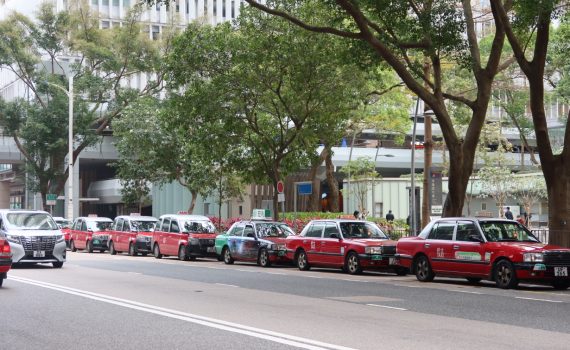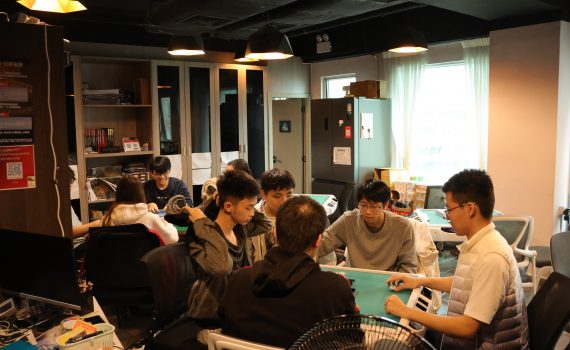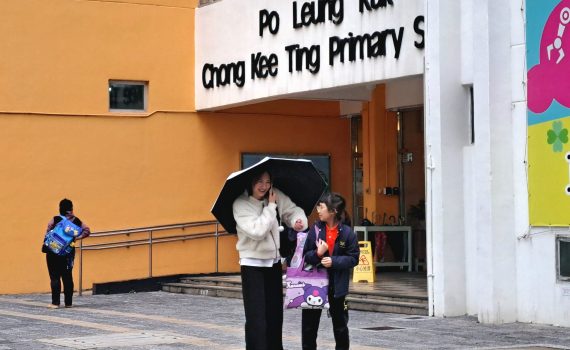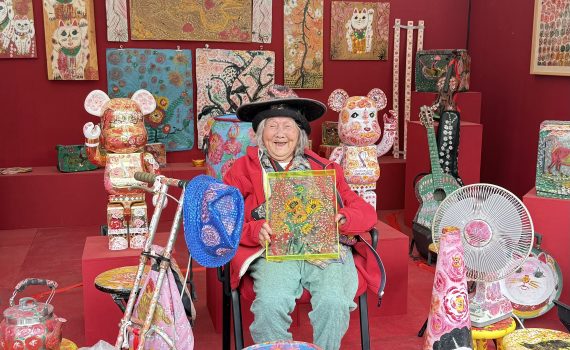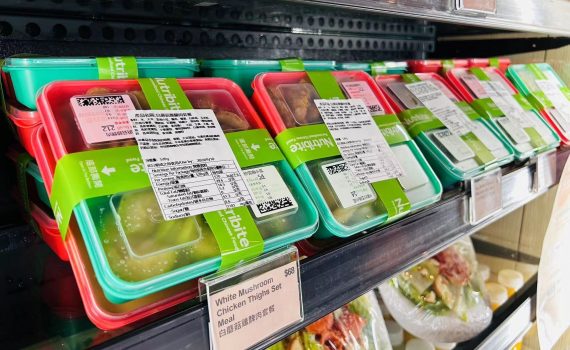Society
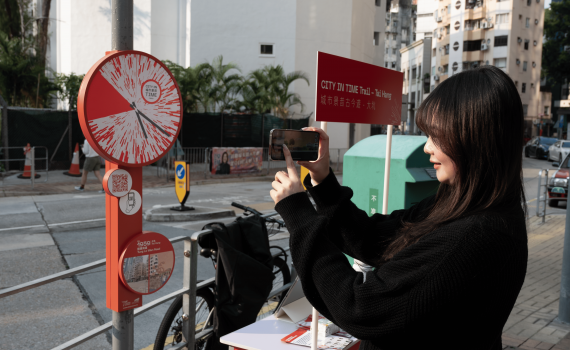
Augmented reality empowers locals to revisit cultural sites
- 2025-04-09
- Society
- By: CHAN Hiu Ying、Ruoyu LIEdited by: Chun Hei LUK
- 2025-04-09
A red clock has mysteriously appeared on street lamps at Tai Hang, allowing people to revisit and immerse in the past cultural events under an augmented reality project called “City In Time”. Jeffery Wang, 15, a secondary student, walked towards the red clock and scanned the QR code. Then a street scene of Tai Hang from the past appeared on his phone. By turning his phone around, he could see what the area looked like from different perspectives. “It is quite an innovative thing. I have only read about Hong Kong’s past in textbooks. City In Time has given me a unique experience to know more about Hong Kong culture,” he said. "City In Time" allows users to compare and experience historical scenes while standing in present-day surroundings at 39 designated locations around Hong Kong. “The AR technology, primarily used in games, now allows users to immerse themselves in real cultural events at the locations they are standing through this app,” said Wong Tsz-yan, 22, a programme promoter. “Such experiences are more realistic compared to some presentations through picture and text descriptions.” “Few people value Hong Kong’s culture anymore, especially its intangible aspects, and some of them are beginning to be lost,” Wong added. Wong hopes the government can do more to preserve local culture, for example, by raising public awareness on traditional handicrafts, so that they will not be forgotten. Richard William Allen, the project director of City In Time and the chair professor at the School of Creative Media at City University of Hong Kong, said that the project was initiated by the Tourism Commision in 2018. They aimed to develop more types of virtual tours and explore innovative ways to share Hong Kong's rich cultural heritage and environment with tourists and the public. “When this opportunity arose, …
New taxi fleets aim to brush up the image of the industry
- 2025-04-09
- Society
- The Young Reporter
- By: ZHOU Yun、CHEN ZiyuEdited by: WANG Jing
- 2025-04-09
At a roadside taxi stand in Mong Kok, Lily Ho, 42, was having a verbal altercation with a taxi driver for taking a detour. “I have repeatedly told the driver that I am in a hurry, but the driver just ignored me and even attacked me with vulgar language,” Ho said. “I often take this route by taxi, and I am sure the driver had taken a detour.” Ho said it was not the first time she had encountered poor service from taxi drivers. Taxi complaints surged 51% year-on-year to 11,452 cases in 2023, with refusal for hire, driving malpractice, and joyriding being the most common, according to the Legislative Council. However, these situations may be addressed as a new taxi fleet is introduced which aims to provide better quality services through technology and improvement in drivers’ attitude , according to Secretary for Transport and Logistics, Mable Chan. Cheung Chi-kwan, 65, vice-chairman of the Hong Kong Taxi Owners’ Association, said the traditional taxi industry in Hong Kong has room for improvement, but it is undergoing changes to refresh the industry. “In the past, the number of taxis in Hong Kong was stable, but the number of orders received has decreased significantly. 20 years ago, the daily passenger capacity was more than 1.2 million passengers, compared to just 750,000 today,” Cheung said. The expansion of the MTR network, illegal pick-up of private car-hailing services and prejudice against the poor Hong Kong taxi service caused the sharp decline, he said. “It was a one-way cross-harbour taxi, but the driver asked me for a round-trip fare,” said Henry Zoeng, 31, a travel blogger. “There is no surveillance inside the taxi, nor is there a unified platform to monitor driving routes and fare issues.” “I prefer to spend more time on the subway or …
Tai O volunteers struggle to save stray cats
- 2025-04-07
- Society
- The Young Reporter
- By: LEUNG Chi Ngai、CHEN YongruEdited by: AO Wei Ying Vinci
- 2025-04-07
Stray cats fouling the streets and stealing food is a nuisance to some residents in Tai O. Many of these cats were killed by dogs. But the fate of stray cats has improved since the establishment of the Tai O Stray Cat Home in 2013. Volunteers have been sterilising stray cats and providing them with food and medical treatments. The volunteers often have trouble catching the cats and have to rely on donations to continue their work. Reported by Chen Yongru, Leung Chi-ngai Edited by Vinci Ao Wei-ying
College students are obsessed with playing mahjong to relieve stress and build friendships
- 2025-04-07
- Society
- The Young Reporter
- By: ZHENG Xinyi、Li YinhengEdited by: LIU Yutong
- 2025-04-07
The rhythmic clatter of mahjong tiles mixed with laughter as four students play a heated round of the traditional game late-night in a Hong Kong Baptist University dormitory. "Midterm exams stressed me out last week," said a local hall tutor at HKBU. "After that, I played mahjong two nights in a row to relax myself." "People will join the game whether they know each other or not. Mahjong has boosted friendships in the building," the tutor added. The student requested not to be named as student hall rules prohibit the playing of mahjong in the building. Amid academic pressure and digital isolation, university students are reviving the nearly 200-year-old Chinese game of mahjong, usually associated with older people, for mental wellness and community-building. At the Hong Kong University of Science and Technology, the mahjong club, which was founded in 2022, has about 1,000 active members and more than 1,700 Instagram followers, said Rex Chow, 20, president of the club. “Our community not only attracts local students but also those from mainland China and internationally,” Chow said. “Some new members even did not know how to play mahjong, but they can learn from our free mentor courses.” According to Google Trends, the number of web searches for mahjong in Hong Kong has increased in fluctuation since December 2024, and peaked late January 2025. “Compared with shopping which is tiring and expensive, playing mahjong is a better way to relax,”said Winnie Leung, 20, a local student at HKBU, who plays mahjong at least once a week. Research in China shows that frequent playing of mahjong as a form of social participation can reduce symptoms of depression. “Maintaining a good mental state is important for coping with a busy life," the tutor said.“I would sometimes sacrifice some of my sleep to play mahjong.” …
Hong Kong Rugby Sevens 2025 draws record high audience
- 2025-04-01
- Society
- By: LEUNG Chi NgaiEdited by: Chun Lim LEUNG
- 2025-04-01
The first Hong Kong Sevens played at Kai Tak Stadium attracted more than 110 thousand fans, the highest since the tournament began in 1982, according to Hong Kong China Rugby . Argentina beat France 12-7 in the men’s cup final and New Zealand beat Australia 26-19 to take home the women’s cup. Hong Kong men's team won the Melrose Claymores against China’s national team, 31 to 7. “Although we were trailing in seven nil, our teammates’ mentality dedicated the comeback against China,” said Jack Combes, rugby player for Hong Kong China 7s men’s team. Matches were played over three days between March 28-30. Tha canopy over the brand new Kai Tak Stadium was closed on day one. “There was a bit more of an echo and sort of the volume, when there were glimpses of quiet, you need to be really clear to each other with your calls and communication,” Jack said. According to the press release from Hong Kong China Rugby, Kai Tak Stadium sold over 82,000 litres of beer and 350,000 food and beverage items over three days. Brodie Buckle, 44, an Australian manager of a home care services company, has travelled to more than five countries and watched the Rugby Sevens 20 times. He visited the Hong Kong Stadium 15 years ago. “Rugby fans are the best fans in the world because they are accepting of everyone”, Brodie said. “Everyone is willing to have a chat, they are willing to tell you about your hometown,” he said, “having multiple teams here is fantastic.” He was amazed by the architecture of Kai Tak Stadium. “How they envision this stadium and how it works out, it is really an incredible experience to have in its own sense,” he said.
Parents react to abolished HK$2500 education grant from budget address
- 2025-03-18
- Society
- The Young Reporter
- By: WONG Hong Ni、QIN ZiyangEdited by: AO Wei Ying Vinci
- 2025-03-18
The cancellation of the HK$2,500 education subsidy has drawn mixed reactions among parents about the latest budget plan, which aims to reduce education expenditures. Cammy To, 34, a mother with a daughter in kindergarten, said she does not consider the grant to be very impactful for her daughter’s education. “My child studies in full-day kindergarten. A month of tuition fee with meal fee is almost HK$1,500. One semester’s textbook fee is about HK$1,100. So a HK$2,500 grant for a year is just better than not having any subsidies,” she added. The grant did not require a means test for application, making it accessible to all families. According to the Education Bureau, around 800,000 applications of the HK$2,500 grant succeeded and nearly HK$2 thousand million were given to households in the academic year of 2023/24. Lan Wong, 53, a parent to a primary school student, expressed confusion about the proposal after the abolishment was proposed. “The original grant did not require a means test that both rich and poor could get it,” said Wong. She added that removing it all of a sudden is unfair for some families, especially for those who need this yearly subsidy. Christine Choi, the head of the Education Bureau, commented on March 7 during a press conference that the abolition was a necessary step to decrease the government’s expenditure while maintaining educational standards in Hong Kong. “The HK$2,500 grant was introduced as a relief measure, we had announced beforehand that it was designed to alleviate challenges,” said Choi. “Families in need could apply for other subsidies that the government is currently providing.” Professor Cheung Chi-keung, the Head of the Department of Educational Administration and Policy at the Chinese University of Hong Kong, also expressed concern. “Removing subsidies for education is deteriorating Hong Kong’s talent cultivation in …
Elderly flower girl turn artist puts on a show at Victoria Park
- 2025-03-17
- Society
- The Young Reporter
- By: CHAN Hiu Ying、LAU Ka YanEdited by: LI Sin Tung
- 2025-03-17
94-year-old local artist, Fapopo, who will not disclose her real name, put on a display of her own with her floral design on furniture and canvases at this year’s Hong Kong Flower Show. Fapopo is her pseudonym for the public. She has been planting, drawing, and arranging flowers for over 50 years. It started when she sold flowers at Mong Kok Flower Market in her twenties and that deepened her passion for floral painting. “I was poor and had no money to buy canvases at first, so I just used unwanted furniture to draw,” she said. “I really appreciate Fapopo’s passion and I am glad that I got to know her story at this year’s Flower Show,” said Ada Tam, a 60-year-old retiree. “Her fascinating journey in pursuing her dream is also very much in line with this year’s theme.” “Ablaze with Glory,” is the theme of this year’s Hong Kong Flower Show, organised by the Leisure and Cultural Services Department (LCSD). The Cosmos, a flower that symbolises resilience and strength, is this year’s chosen flower. Some 40,000 varieties of it are on display in an array of colours including yellow, pink and white. A total of 238 organisations participate in this year’s event, including 157 from Hong Kong and 81 from 11 countries. Raymond Ng, a 77-year-old photographer, said the Cosmos is now growing well as early spring brings ample but not intense sunshine. Its brightness brings vitality to Hong Kong. Eileen Lau, a retiree in her sixties, said the Cosmos is appealing and colourful, which can represent the vibrancy as the theme of the show. “But I also worry if the Cosmos would wither easily because it looked so fragile and thin,” Lau said. “I actually do not have much feeling about the chosen flowers as I care …
Special-forces mainland travellers are changing the Hong Kong tourism industry
- 2025-03-06
- Society
- The Young Reporter
- By: CHAU Wing YauEdited by: KURNIAWAN Trista Vania
- 2025-03-06
It is 10 am and the Mong Kok footbridge is already buzzing with people. Tourists snap photos of the Hong Kong skyline with luggage in hand, before hurrying to their next stop. They walk thousands of steps and visit as many attractions as possible in a day. They are the so-called special-forces tourists in Hong Kong. Like soldiers, they move from one location to another under tight schedules, often over the weekends or holidays such as Labour Day and the Qing Ming festival. Special-forces tourism is a growing trend among mainland tourists, who have become major contributors to Hong Kong’s tourism industry. According to the Hong Kong Tourism Board, 21 million visitors arrived in Hong Kong in the first half of 2024, with 77% of them from the mainland. On holidays such as National Day, the Immigration Department recorded 1.22 million mainland visitors, making up 88% of the total number of tourists. The Hong Kong Tourism Board also shows a 34% increase in mainland day-trippers to Hong Kong from 2023 to 2024, causing challenges to the city’s hospitality sector. Yu Li, 25, counts herself as a special-forces tourist. She planned to explore three districts – Mong Kok, Tsim Sha Tsui and Central, in a day. “Last time I came here, I mainly went hiking along the MacLehose Trail, and this time I am here with my friend just to explore,” she said. Li said she found her destinations through Rednote, the Chinese social media app where users commonly share and recommend travel plans. “I have not been to the Hong Kong Museum of Art in Tsim Sha Tsui before, but the recommendations in Rednote made me interested in what it features,” she said. She said she only spends around HK$2,000 a day. “I mostly shop for medicine and smaller things …
Health-seeking shoppers pick balanced meals via labeled diet boxes
- 2025-03-04
- Society
- The Young Reporter
- By: Fu Rong、Wong Kit YingEdited by: LIU Yutong
- 2025-03-04
Marimo Lai, a 53-year-old clerk in Hong Kong, sat in the canteen and took out a blood glucose monitor from her bag before having lunch. Since being diagnosed with type 2 diabetes two years ago, testing her blood sugar level has become part of her daily routine. The results showed her blood sugar was stable. Marimo has been ordering her food under a personalized meal plan for two years. “Ever since I found this kind of lunch box, it has been much easier to control my blood sugar,” she said. Marimo’s food is from Nutribute, a catering company that claims to provide a balanced diet. A typical meal costs $63 per set and more for special needs such as diabetes and pregnancy. Nutribite has sold 22 million meal boxes in 2024, and sold their products at more than 100 Pacific Coffee shops and Hung Fook Tong shops in Hong Kong, showing more Hongkongers want to embrace a healthier diet with convenience labeled nutritional lunch boxes, said Susan So, the general manager of Nutribite. At present, about 700,000 people in Hong Kong suffer from diabetes, according to the Hong Kong Diabetes Federation, and it will surge to 920 ,000 by 2030, accounting for 13% of the total population. Terry Ting, 50, is a registered dietitian. “As more people recognize the importance of a balanced diet especially after the pandemic but lack the time and money to cook for themselves, the demand for such services will grow,” he said. He thinks these food companies should follow government guidelines in their nutrition labels. Other healthy food delivery platforms in Hong Kong include WeBite, Eatology, Fittery, Nosh and Calfit. WeBite specialises in group meal deliveries to offices and campuses. “They started to provide this service to Hong Kong Baptist University in November 2024, and …
Cross-border marathon to prepare for 15th National Games
- 2025-03-03
- Society
- The Young Reporter
- By: Fu RongEdited by: AO Wei Ying Vinci
- 2025-03-03
Runners from Hong Kong and Shenzhen join the first cross-border marathon in a test event in preparation for the National Games to be held in November.

